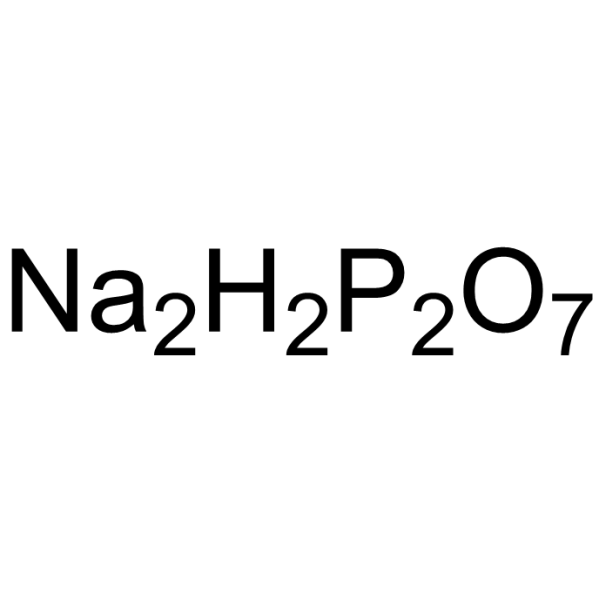Disodium dihydrogen diphosphate

Disodium dihydrogen diphosphate structure
|
Common Name | Disodium dihydrogen diphosphate | ||
|---|---|---|---|---|
| CAS Number | 7758-16-9 | Molecular Weight | 221.93900 | |
| Density | 2.311 g/cm3 (25ºC) | Boiling Point | N/A | |
| Molecular Formula | H2Na2O7P2 | Melting Point | 988ºC | |
| MSDS | Chinese USA | Flash Point | N/A | |
| Symbol |

GHS07 |
Signal Word | Warning | |
Use of Disodium dihydrogen diphosphateDisodium pyrophosphate (SAPP), a food additive, is an inorganic compound. Disodium pyrophosphate has potential hematotoxic and immunotoxic effects[1]. |
| Name | Disodium pytophosphate |
|---|---|
| Synonym | More Synonyms |
| Description | Disodium pyrophosphate (SAPP), a food additive, is an inorganic compound. Disodium pyrophosphate has potential hematotoxic and immunotoxic effects[1]. |
|---|---|
| Related Catalog | |
| In Vivo | Disodium pyrophosphate (oral administration, 12.6 mg/kg) displays hematotoxic and immunotoxic effects with long-term exposure in rats[1]. Animal Model: Adult Sprague-Dawley rats[1] Dosage: 12.6 mg/kg Administration: Oral administration Result: Displayed significant leukopenic condition. Decreased in CD3 T-lymphocyte and CD20 Blymphocyte immunolabeling in rats. Downregulated of PPAR-α and PPAR-γ together with upregulation of TNF-α. |
| References |
| Density | 2.311 g/cm3 (25ºC) |
|---|---|
| Melting Point | 988ºC |
| Molecular Formula | H2Na2O7P2 |
| Molecular Weight | 221.93900 |
| Exact Mass | 221.90700 |
| PSA | 149.57000 |
| LogP | 0.06480 |
| Stability | Stable. |
| Water Solubility | H2O: 0.1 M at 20 °C, clear, colorless |
CHEMICAL IDENTIFICATION
HEALTH HAZARD DATAACUTE TOXICITY DATA
|
| Symbol |

GHS07 |
|---|---|
| Signal Word | Warning |
| Hazard Statements | H319 |
| Precautionary Statements | P305 + P351 + P338 |
| Personal Protective Equipment | Eyeshields;Gloves;type N95 (US);type P1 (EN143) respirator filter |
| Hazard Codes | Xi |
| Risk Phrases | 36 |
| Safety Phrases | S24/25 |
| RIDADR | NONH for all modes of transport |
| WGK Germany | 2 |
| RTECS | UX6475000 |
| HS Code | 2835399000 |
| HS Code | 2835399000 |
|---|
|
Pharmacological characterization of [3H]VUF11211, a novel radiolabeled small-molecule inverse agonist for the chemokine receptor CXCR3.
Mol. Pharmacol. 87(4) , 639-48, (2015) Chemokine receptor CXCR3 has attracted much attention, as it is thought to be associated with a wide range of immune-related diseases. As such, several small molecules with different chemical structur... |
|
|
Mitochondria-localized NAD biosynthesis by nicotinamide mononucleotide adenylyltransferase in Jerusalem artichoke (Helianthus tuberosus L.) heterotrophic tissues.
Planta 234(4) , 657-70, (2011) Current studies in plants suggest that the content of the coenzyme NAD is variable and potentially important in determining cell fate. In cases that implicate NAD consumption, re-synthesis must occur ... |
|
|
Fabrication of biopolymer-based staple electrospun fibres for nanocomposite applications by particle-assisted low temperature ultrasonication.
Mater. Sci. Eng. C. Mater. Biol. Appl. 45 , 277-86, (2014) We demonstrate the fabrication of staple polymer-based fibres by the ultrasound-assisted processing of electrospun meshes. Bioabsorbable Poly-L-Lactic Acid (PLLA) was electrospun from organic solvent ... |
| DISODIUM PYROPHOSPHATE |
| Disodium dihydrogen diphosphate |
| SAPP 28 |
| SAPP |
| disodiumdiphosphate |
| DSPP |
| MFCD00014246 |
| EINECS 231-835-0 |
| SAPP 40 |
| DisodiuM pytophospha |
| dinatriumpyrophosphat |
| Phosphonate, P,P'-oxybis-, sodium salt (1:2) |
| sodiumpyrophosphate,acid |

